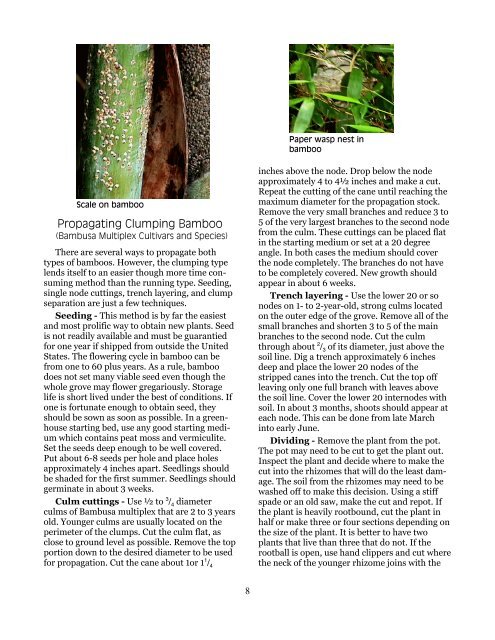Growing Bamboo in Georgia - Orange County Extension Education ...
Growing Bamboo in Georgia - Orange County Extension Education ...
Growing Bamboo in Georgia - Orange County Extension Education ...
You also want an ePaper? Increase the reach of your titles
YUMPU automatically turns print PDFs into web optimized ePapers that Google loves.
Scale on bamboo<br />
Propagat<strong>in</strong>g Clump<strong>in</strong>g <strong>Bamboo</strong><br />
(Bambusa Multiplex Cultivars and Species)<br />
There are several ways to propagate both<br />
types of bamboos. However, the clump<strong>in</strong>g type<br />
lends itself to an easier though more time consum<strong>in</strong>g<br />
method than the runn<strong>in</strong>g type. Seed<strong>in</strong>g,<br />
s<strong>in</strong>gle node cutt<strong>in</strong>gs, trench layer<strong>in</strong>g, and clump<br />
separation are just a few techniques.<br />
Seed<strong>in</strong>g - This method is by far the easiest<br />
and most prolific way to obta<strong>in</strong> new plants. Seed<br />
is not readily available and must be guarantied<br />
for one year if shipped from outside the United<br />
States. The flower<strong>in</strong>g cycle <strong>in</strong> bamboo can be<br />
from one to 60 plus years. As a rule, bamboo<br />
does not set many viable seed even though the<br />
whole grove may flower gregariously. Storage<br />
life is short lived under the best of conditions. If<br />
one is fortunate enough to obta<strong>in</strong> seed, they<br />
should be sown as soon as possible. In a greenhouse<br />
start<strong>in</strong>g bed, use any good start<strong>in</strong>g medium<br />
which conta<strong>in</strong>s peat moss and vermiculite.<br />
Set the seeds deep enough to be well covered.<br />
Put about 6-8 seeds per hole and place holes<br />
approximately 4 <strong>in</strong>ches apart. Seedl<strong>in</strong>gs should<br />
be shaded for the first summer. Seedl<strong>in</strong>gs should<br />
germ<strong>in</strong>ate <strong>in</strong> about 3 weeks.<br />
Culm cutt<strong>in</strong>gs - Use ½ to 3 / 4 diameter<br />
culms of Bambusa multiplex that are 2 to 3 years<br />
old. Younger culms are usually located on the<br />
perimeter of the clumps. Cut the culm flat, as<br />
close to ground level as possible. Remove the top<br />
portion down to the desired diameter to be used<br />
for propagation. Cut the cane about 1or 1 1 / 4<br />
8<br />
Paper wasp nest <strong>in</strong><br />
bamboo<br />
<strong>in</strong>ches above the node. Drop below the node<br />
approximately 4 to 4½ <strong>in</strong>ches and make a cut.<br />
Repeat the cutt<strong>in</strong>g of the cane until reach<strong>in</strong>g the<br />
maximum diameter for the propagation stock.<br />
Remove the very small branches and reduce 3 to<br />
5 of the very largest branches to the second node<br />
from the culm. These cutt<strong>in</strong>gs can be placed flat<br />
<strong>in</strong> the start<strong>in</strong>g medium or set at a 20 degree<br />
angle. In both cases the medium should cover<br />
the node completely. The branches do not have<br />
to be completely covered. New growth should<br />
appear <strong>in</strong> about 6 weeks.<br />
Trench layer<strong>in</strong>g - Use the lower 20 or so<br />
nodes on 1- to 2-year-old, strong culms located<br />
on the outer edge of the grove. Remove all of the<br />
small branches and shorten 3 to 5 of the ma<strong>in</strong><br />
branches to the second node. Cut the culm<br />
through about 2 / 3 of its diameter, just above the<br />
soil l<strong>in</strong>e. Dig a trench approximately 6 <strong>in</strong>ches<br />
deep and place the lower 20 nodes of the<br />
stripped canes <strong>in</strong>to the trench. Cut the top off<br />
leav<strong>in</strong>g only one full branch with leaves above<br />
the soil l<strong>in</strong>e. Cover the lower 20 <strong>in</strong>ternodes with<br />
soil. In about 3 months, shoots should appear at<br />
each node. This can be done from late March<br />
<strong>in</strong>to early June.<br />
Divid<strong>in</strong>g - Remove the plant from the pot.<br />
The pot may need to be cut to get the plant out.<br />
Inspect the plant and decide where to make the<br />
cut <strong>in</strong>to the rhizomes that will do the least damage.<br />
The soil from the rhizomes may need to be<br />
washed off to make this decision. Us<strong>in</strong>g a stiff<br />
spade or an old saw, make the cut and repot. If<br />
the plant is heavily rootbound, cut the plant <strong>in</strong><br />
half or make three or four sections depend<strong>in</strong>g on<br />
the size of the plant. It is better to have two<br />
plants that live than three that do not. If the<br />
rootball is open, use hand clippers and cut where<br />
the neck of the younger rhizome jo<strong>in</strong>s with the
















